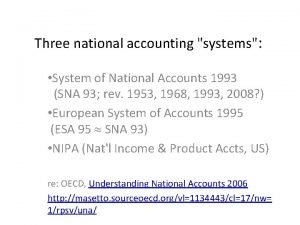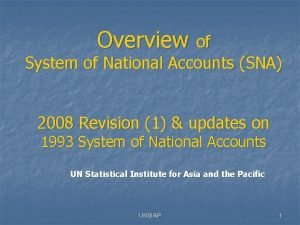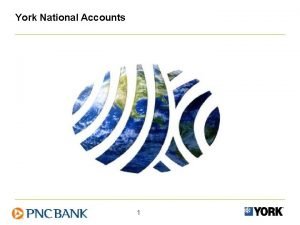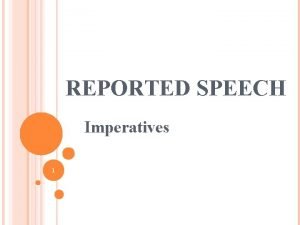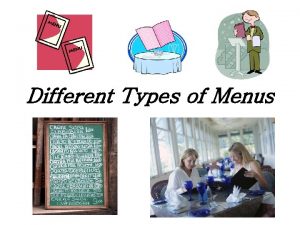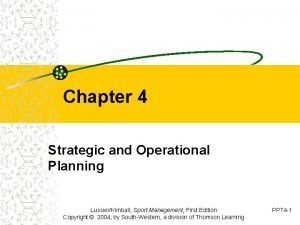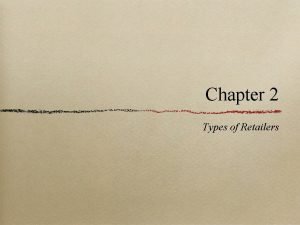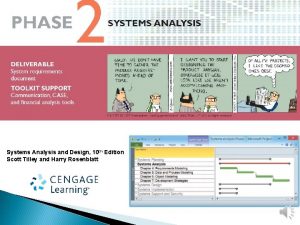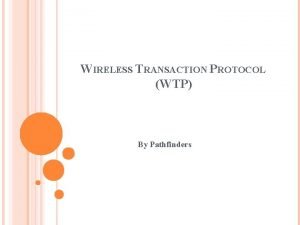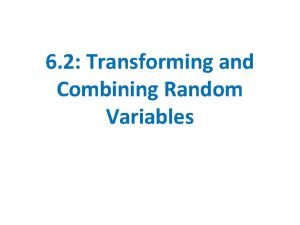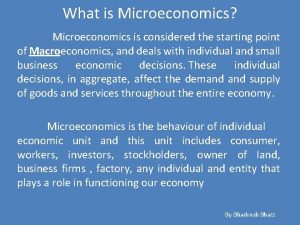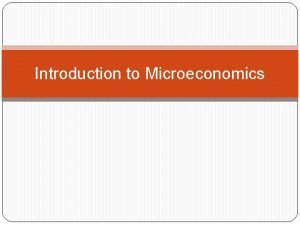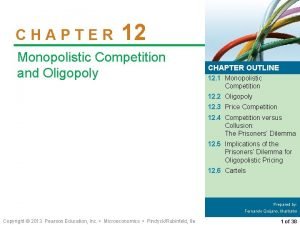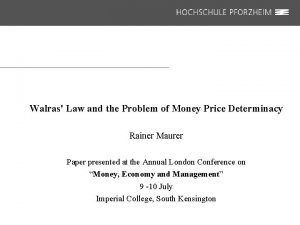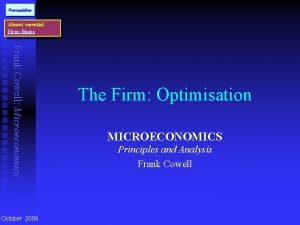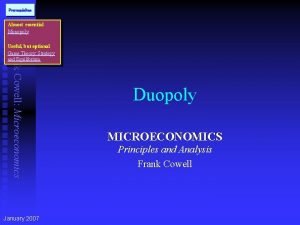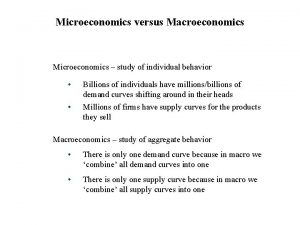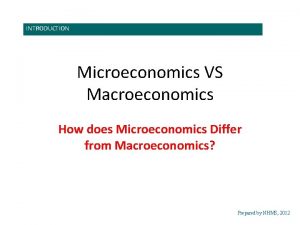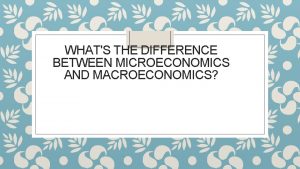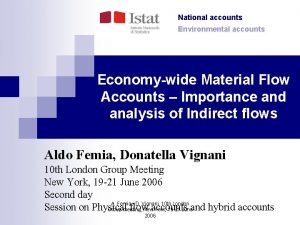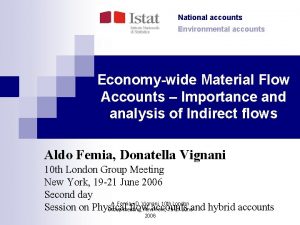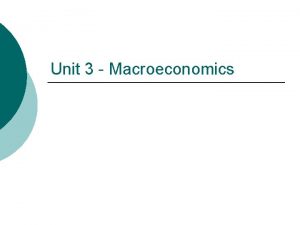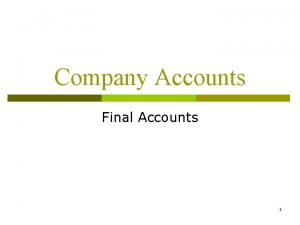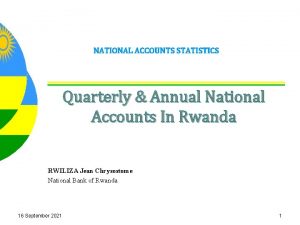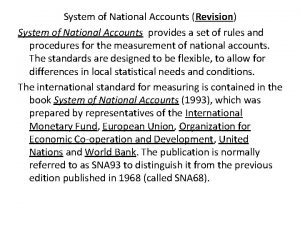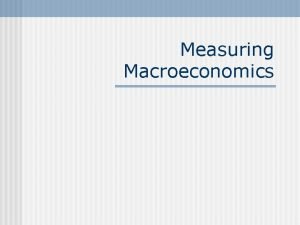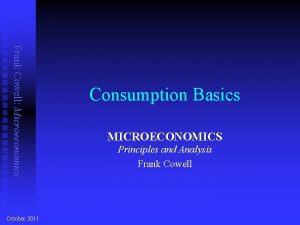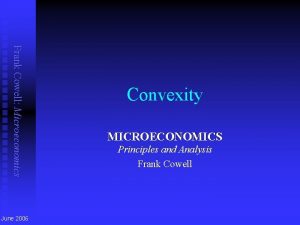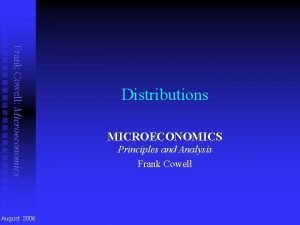The System of National Accounts Macroeconomics Microeconomics offers








































- Slides: 40

The System of National Accounts

Macroeconomics • Microeconomics offers a detailed analysis of particular activities in the economy. For simplicity, it may neglect some interactions with the rest of the economy. • Macroeconomics emphasizes these interactions at the cost of simplifying the individual building blocks. • Macroeconomics is the study of the economy as a system. Reminder

Microeconomics and Macroeconomics (Main topics / Examples) § Microeconomics studies choice and its implications for price and quantity in individual markets § Sugar § Carpets § House cleaning services § Microeconomics considers topics such as § Costs of production § Demand for a product § Market structures § Macroeconomics studies the performance of national economies and the policies that governments use to try to improve that performance § Inflation § Unemployment § Growth § Macroeconomics considers § Monetary policy § Deficits § Tax policy 3

Measuring the Economy Indicators • Gross domestic product (GDP) measures the output made in the domestic economy, regardless of who owns the production inputs. • Real gross national product (GNP) measures the income of an economy, the quantity of goods and services the economy can afford to purchase. • The price level is a weighted average of the prices households pay for goods and services. • The inflation rate is the percentage increase in the average price of goods and services. • The labour force is people at work or looking for work. It excludes people neither working nor looking for work. • The unemployment rate is the fraction of the labour force without a job. 4

A closed economy (=not linked to the rest of the world) without a government • Households own the factors of production: – Households rent labour to firms in exchange for wages. – Households are also the ultimate owners of firms, and get their profits. – Capital and land, even if held by firms, are ultimately owned by households. • Firms use these inputs to make output.

Transactions by households and firm Households Supply factor services to firms Receive factor incomes from firms Buy output of firms Firms Use factors to make output Rent factor services from households Sell output to households

The circular flow shows how real resources and financial payments flow between firms and households. The inner loop shows flows of real resources between the sectors. The outer loop shows the corresponding flows of money in a market economy.

The circular flow between firms and A centrally households (simplified) planned economy could arrange the transfers in the inner loop without using the outer loop. Spending on goods and services Goods and services Households Firms Services of productive factors Factor incomes

3 ways to measure economic activity • The value of goods and services produced; • The level of factor earnings, which represent the value of factor services supplied; • The value of spending on goods and services. In a simple model: • Factor incomes equal household spending if all income is spent. (What happens if households do not spend all their incomes? ) • The value of output equals total spending on goods and services if all goods are sold. (What happens if firms do not sell all their output? ) • The value of output also equals the value of household incomes. (In a closed economy output and income are the same. )

Value added + Production process • Transactions do not take place exclusively between a single firm and a single household. • Firms hire labour services from households but buy raw materials and machinery from other firms. • To avoid double counting, we use value added. • Value added is the increase in the value of goods as a result of the production process.

Final and intermediate goods • To get value added, we take the firm’s output then deduct the cost of input goods used up to make that output. • Final goods are purchased by the ultimate user, either households buying consumer goods or firms buying capital goods such as machinery. • Intermediate goods are partly finished goods that form inputs to a subsequent production process that then uses them up. Inputs

Calculating GDP (1) Good (2) Seller (3) Buyer (4) (5) Transac. Value tion value added (6) Spen(7) ding on Factor final goods earnings Steel maker Machine maker £ 1000 – £ 1000 Steel maker Car maker £ 3000 – £ 3000 Machine maker Car maker £ 2000 £ 1000 Tyres Tyre maker Car maker £ 500 – £ 500 Cars Car maker Households £ 1500 £ 5000 £ 1500 £ 7000 Total transactions GDP £ 5000 £ 11500

Investment and saving • Investment (I) is the purchase of new capital goods by firms. Saving (S) is the part of income not spent buying goods and services. • In our example, households spend £ 5000 on cars. Since their income is £ 7000, they save £ 2000. • The car maker spends £ 2000 on investments, buying new machinery.

Transactions by households Households wages† con Labour market sum pr of transfer payments taxes sa its vin ptio n , in gs te re st, ‡ Commodity re n market Government †Also: bonuses etc. Generally: Employment income ts Financial markets ‡C denotes household spending on consumption

Transactions by firms wages Firms transfer payments out put taxes Government Labour market inve pr stment ofi s* ts, Commodity int market inv eres tm , ren ts Financial markets *I denotes investments, including stock changes

Transactions by the government Commodity market Firms transfer payments taxes Government transfer payments taxes Households ent m ern g on v o g din d n e sp an s d goo ices serv su rp lus or d efi cit Financial markets

Government interference • Governments raise revenue both through direct taxes Td on incomes (wages, rents, interests, and profits) and through indirect taxes Te (VAT, petrol duties, cigarette taxes). • Taxes finance two kinds of expenditure. Government spending on goods and services G is purchased by the government of physical goods and services. Governments also spend money on transfer payments or benefits, B.

Measuring GDP • National income accounts aim to provide a logically coherent set of definitions and measures of national output. However, taxes drive a wedge between the price the purchaser pays and the price the seller receives. • We can choose to value national output either at market prices inclusive of indirect taxes on goods and services, or at the prices received by producers after indirect taxes have been paid.

GDP at market/basic prices • GDP at market prices measures domestic output inclusive of indirect taxes on goods and services. • GDP at basic prices measures domestic output exclusive of indirect taxes on goods and services. GDP at market prices ≡ final spending ≡ C + I + G Y ≡ GDP at basic prices ≡ [C + I + G] – Te

I GDP at market prices C+I+G GDP at basic prices C S G Households C + I + G − Te Te Government Firms B – Td Y + B – Td Y

The foreign sector • An open economy is also transacting with the rest of the world (= other countries). • Exports (X) are domestically produced but sold abroad. • Imports (Z) are produced abroad but purchased for use in the domestic economy. • Y ≡ C + I + G + X – Z – Te Leakages • S + T d + Te – B + Z ≡ I + G + X Injections • S – I ≡ [G + B – Te – Td] + NX

From GDP to GNI • So far we have assumed that all factors of production are domestically owned: all net domestic output accrues to domestic households as factor incomes. • Example: Suzuki has a car factory in Hungary some of the profits are sent back to Japan to be spent or saved by Japanese households. • Conversely, Hungarian households can earn income from owning foreign assets.

Property income • This income from interest, dividends, profits, and rents is shown in the national accounts as the flow of property income between countries. • The net flow of property income into a country is the excess of inflows of property income from factor services supplied abroad over the outflows of property income from factor services by foreigners in the domestic economy.

GDP and GNP/GNI • When there is a net flow of property income between a country and the rest of the world, the output and expenditure measure of GDP will no longer equal the total factor incomes earned by its citizens. • GNP (or GNI) measures total income earned by domestic citizens regardless of the country in which their factor services were supplied. GNP = GDP + net property income from abroad

From GNP to national income • Depreciation is a flow concept telling us how much our effective capital stock is being used up in each time period. Depreciation is an economic cost because it measures resources being used up in the production process. • The part of the economy’s gross output used merely to replace existing capital is not available for consumption, investment in net additions to the capital stock, government spending, or exports.

National income or NNP • Similarly, we need to reduce our measure of the incomes available for spending on these goods. Thus, we subtract depreciation from GNP to get NNP (Net National Product). • National income is the economy’s net national product. It is calculated by subtracting depreciation from GNP at basic prices. • National income measures how much the economy can spend or save, after setting aside enough resources to maintain the capital stock intact by offsetting depreciation.

National income accounting GNP at market prices Net property income from abroad G GDP at market prices I (also GNI at market prices) NX C Depreciation NNP at market prices Indirect taxes National income (NI) = NNP at basic prices Rental income Profits Income from selfemployment Wages and salaries

Nominal and real GNP • Nominal GNP measures GNP at the prices prevailing when income was earned. • Since it is physical quantities of output that yield people utility or happiness, it can be misleading to judge the economy’s performance by looking at nominal GNP. • Real GNP, or GNP at constant prices, adjusts for inflation by measuring GNP in different years at the prices prevailing at some particular date known as the base year.

The GNP deflator • To convert nominal GNP to real GNP we need to use an index showing what is happening to the price of all goods. This index is called the GNP deflator. * • The GNP deflator is the ratio of nominal GNP to real GNP expressed as an index. To express the deflator as an index, we take the ratio of nominal to real GNP and multiply by 100. *The GNP deflator and Consumer/Retail Price Indices are both used to show ”what is happening to prices”, but CPI only refers to changes in the price of consumption goods.

Per capita real GNP • Per capita real GNP is real GNP divided by the total population. • For a given real GNP, the larger the population the smaller the quantity of goods and services person. • To get a simple measure of the standard of living enjoyed by a person in a particular country, it is better to look at per capita real GNP, which adjusts for population, than to look at total real GNP.

Inflation • To keep track of prices faced by consumers, countries construct a consumer price index (CPI, in the UK a similar index is the Retail Price Index (RPI), in the EU the ECB calculates a Harmonized Index of Consumer Prices, HICP). • These indices are used to measure changes in the cost of living, the money that must be spent to purchase the typical bundle of goods consumed by a representative household. 31

Calculating inflation rates (example) • The consumer price index is calculated in two stages. First, index numbers* are calculated for each category of commodity purchased by households. • Then the consumer price index is constructed by taking a weighted average of the different commodity groupings. *An index number expresses data relative to a given base value 32

Calculating index numbers • The procedure by which index numbers are calculated is always the same. We choose a base date at which to set the index equal to 100, then calculate other values relative to this baseline. • When the index refers to more than one commodity, we have to choose weights by which to average across the different commodities that the index describes. 33

Measuring changes in economic variables • The percentage change is the absolute change divided by the original number, then multiplied by 100. • The growth rate is the percentage change period (usually a year). • Reminder: Economic growth is a rise in real GNP (growth rate is the percentage change per year); the inflation rate is the percentage increase in the average price of goods and services. 34

Example: Exercises 1, 2 on page 86 (of the student workbook) • Exercise 1 (inflation rate: π) • Exercise 2 (growth rate: g) 35

Nominal and real variables • Nominal values are measured in the prices ruling at the time of measurement. Real values adjust nominal values for changes in the price level. • Consider the price of television over the last 30 years. TV prices, measured in USD, have hardly changed. The CPI has risen a lot. • The real price of TVs has fallen. Advances in technology reduced the cost of producing televisions. 36

The purchasing power of money • When the price of goods rises, the purchasing power (PP) of money falls because € 1 buys fewer goods. • The purchasing power of money is an index of the quantity of goods that can be bought for € 1 (or HUF 1, CHF 1, LYD 1, EGP 1 etc. ) • To distinguish real and nominal variables we say that real variables measure nominal variables if the PP of money had been constant. 37

Example: The oil price shock of 1973 • Until 1973 the use of oil had increased steadily. Oil was cheap and abundant. • The Organization of Petroleum Exporting Countries (OPEC) became active in 1973. • OPEC organized a production cutback by its members, making oil so scarce that the price tripled. Users could not quickly do without oil. Making oil scarce was very profitable for OPEC members. 38

The real price of oil 1960 -2010 Oil price shocks: • 1973 -74 • 1979 -80 The figure on the left shows the real price of oil from 1960 to 2008. 39

Oil price shocks • The price tripled in 1973 -74 and doubled again in 1979 -80. Yet the figure on the previous slide shows that markets found ways to overcome the oil shortage that OPEC had created. • Given time, the higher price induced consumers to use less and non-OPEC countries to sell more. 40
 Define macroeconomics
Define macroeconomics Definition of macroeconomics
Definition of macroeconomics System of national accounting
System of national accounting System of national accounts (sna)
System of national accounts (sna) York national accounts
York national accounts National income and product accounts
National income and product accounts Advisory expert group on national accounts
Advisory expert group on national accounts Universal library offers
Universal library offers Imperatives reported speech
Imperatives reported speech Different types of menu
Different types of menu How an organization offers unique customer value
How an organization offers unique customer value Type of retails
Type of retails Amadeus offers
Amadeus offers All things considered being a senior offers a student
All things considered being a senior offers a student He-y come on ou-t by shinichi hoshi
He-y come on ou-t by shinichi hoshi The cask of amontillado literary analysis answers
The cask of amontillado literary analysis answers A firm that offers outsourcing solutions is called a
A firm that offers outsourcing solutions is called a A person usually offers the most resistance to electricity
A person usually offers the most resistance to electricity Xmpp offers extensibility to mcq
Xmpp offers extensibility to mcq Explain wireless transaction protocol
Explain wireless transaction protocol I stand all amazed at the love jesus offers me
I stand all amazed at the love jesus offers me Absa home loan outstanding balance
Absa home loan outstanding balance Uac atar cut offs 2021
Uac atar cut offs 2021 Transforming and combining random variables
Transforming and combining random variables What is microeconomics
What is microeconomics What is the subject matter of microeconomics
What is the subject matter of microeconomics Limitation of microeconomics
Limitation of microeconomics Intermediate microeconomics lecture notes
Intermediate microeconomics lecture notes Intermediate microeconomics notes
Intermediate microeconomics notes Cartel microeconomics
Cartel microeconomics Walras law economics
Walras law economics Pure public good
Pure public good Frank cowell
Frank cowell Economics michael parkin 13th edition
Economics michael parkin 13th edition Objective of microeconomics
Objective of microeconomics Microeconomics
Microeconomics Microeconomics
Microeconomics Uses of microeconomics
Uses of microeconomics Example of macroeconomics
Example of macroeconomics Microeconomics chapter 12
Microeconomics chapter 12 Cowell microeconomics
Cowell microeconomics


